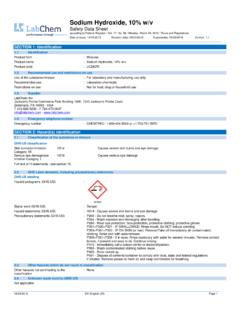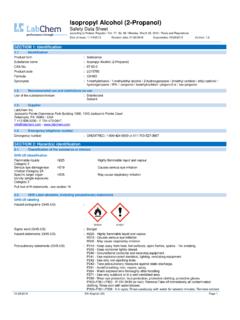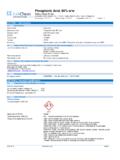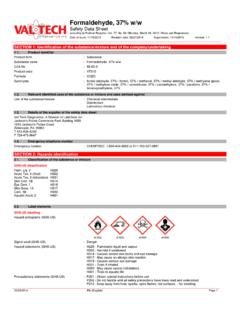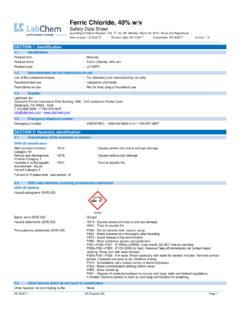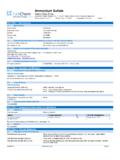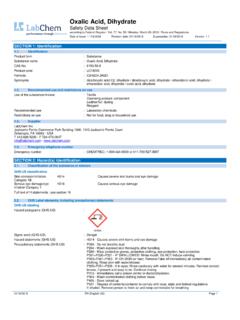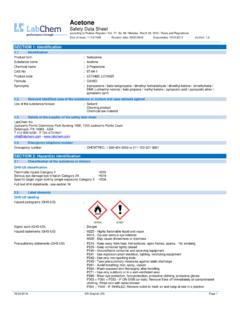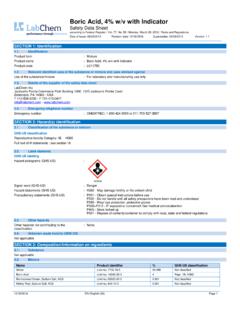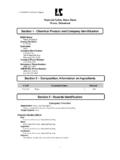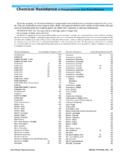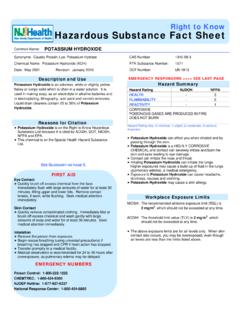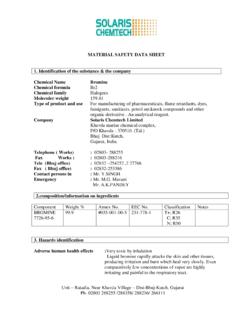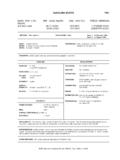Transcription of Potassium Hydroxide
1 Potassium Hydroxide Safety Data Sheet according to Federal Register / Vol. 77, No. 58 / Monday, March 26, 2012 / Rules and Regulations Date of issue: 10/09/2004 Revision date: 02/06/2018 Supersedes: 02/06/2018 Version: 02/06/2018 EN (English US) Page 1 SECTION 1: Identification Identification Product form : Substance Substance name : Potassium Hydroxide CAS-No. : 1310-58-3 Product code : LC19190 Formula : KOH Synonyms : caustic potash / caustic potash dry / caustic potash, dry solid, flake, bead or granular / caustic potash, solid / caustic potash,solid / hydrate of potash / hydrate of Potassium / Hydroxide of potash / Hydroxide of Potassium / lye (= Potassium Hydroxide ) / potash / potash hydrate / potash lye / Potassium hydrate / Potassium Hydroxide (K(OH)) / Potassium Hydroxide dry / Potassium Hydroxide pellets / Potassium Hydroxide , dry solid, flake, bead or granular / Potassium Hydroxide , electrolytical, solid / Potassium Hydroxide , solid / Potassium Hydroxide , solid / Potassium lye Recommended use and restrictions on use Use of the substance/mixture : For laboratory and manufacturing use only.
2 Recommended use : Laboratory chemicals Restrictions on use : Not for food, drug or household use Supplier LabChem Inc Jackson's Pointe Commerce Park Building 1000, 1010 Jackson's Pointe Court Zelienople, PA 16063 - USA T 412-826-5230 - F 724-473-0647 - Emergency telephone number Emergency number : CHEMTREC: 1-800-424-9300 or 011-703-527-3887 SECTION 2: Hazard(s) identification Classification of the substance or mixture GHS-US classification Acute toxicity (oral) Category 4 H302 Harmful if swallowed Skin corrosion/irritation Category 1A H314 Causes severe skin burns and eye damage Hazardous to the aquatic environment - Acute Hazard Category 3 H402 Harmful to aquatic life Full text of H statements : see section 16 GHS Label elements, including precautionary statements GHS-US labeling Hazard pictograms (GHS-US) : GHS05 GHS07 Signal word (GHS-US) : Danger Hazard statements (GHS-US) : H302 - Harmful if swallowed H314 - Causes severe skin burns and eye damage H402 - Harmful to aquatic life Precautionary statements (GHS-US) : P260 - Do not breathe dust.
3 P264 - Wash exposed skin thoroughly after handling. P270 - Do not eat, drink or smoke when using this product. P273 - Avoid release to the environment. P280 - Wear protective gloves, protective clothing, eye protection, face protection. P301+P330+P331 - IF SWALLOWED: Rinse mouth. Do NOT induce vomiting. Potassium Hydroxide Safety Data Sheet according to Federal Register / Vol. 77, No. 58 / Monday, March 26, 2012 / Rules and Regulations 02/06/2018 EN (English US) 2/8 P303+P361+P353 - IF ON SKIN (or hair): Remove/Take off immediately all contaminated clothing. Rinse skin with water/shower. P305+P351+P338 - If in eyes: Rinse cautiously with water for several minutes. Remove contact lenses, if present and easy to do. Continue rinsing P310 - Immediately call a poison center or doctor/physician. P363 - Wash contaminated clothing before reuse. P405 - Store locked up. P501 - Dispose of contents/container to comply with local, state and federal regulations If inhaled: Remove person to fresh air and keep comfortable for breathing Other hazards which do not result in classification Other hazards not contributing to the classification : None under normal conditions.
4 Unknown acute toxicity (GHS US) Not applicable SECTION 3: Composition/Information on ingredients Substances Substance type : Mono-constituent Name Product identifier % GHS-US classification Potassium Hydroxide (Main constituent) (CAS-No.) 1310-58-3 100 Acute Tox. 4 (Oral), H302 Skin Corr. 1A, H314 Aquatic Acute 3, H402 Full text of hazard classes and H-statements : see section 16 Mixtures Not applicable SECTION 4: First-aid measures Description of first aid measures First-aid measures general : Check the vital functions. Unconscious: maintain adequate airway and respiration. Respiratory arrest: artificial respiration or oxygen. Cardiac arrest: perform resuscitation. Victim conscious with labored breathing: half-seated. Victim in shock: on his back with legs slightly raised. Vomiting: prevent asphyxia/aspiration pneumonia. Prevent cooling by covering the victim (no warming up). Keep watching the victim. Give psychological aid. Keep the victim calm, avoid physical strain.
5 Depending on the victim's condition: doctor/hospital. First-aid measures after inhalation : Remove the victim into fresh air. Doctor: administration of corticoid spray. Respiratory problems: consult a doctor/medical service. First-aid measures after skin contact : Wash immediately with lots of water (15 minutes)/shower. Do not apply (chemical) neutralizing agents. Remove clothing while washing. Do not remove clothing if it sticks to the skin. Cover wounds with sterile bandage. Consult a doctor/medical service. If burned surface > 10%: take victim to hospital. First-aid measures after eye contact : Rinse immediately with plenty of water for 15 minutes. Cover eyes aseptically. Do not apply neutralizing agents. Take victim to an ophthalmologist. First-aid measures after ingestion : Rinse mouth with water. Immediately after ingestion: give lots of water to drink. Do not induce vomiting. Do not give activated charcoal. Immediately consult a doctor/medical service.
6 Call Poison Information Centre ( ). Ingestion of large quantities: immediately to hospital. Take the container/vomit to the doctor/hospital. Do not give chemical antidote. Most important symptoms and effects (acute and delayed) Symptoms/effects after inhalation : AFTER INHALATION OF DUST: Dry/sore throat. Corrosion of the upper respiratory tract. Respiratory difficulties. FOLLOWING SYMPTOMS MAY APPEAR LATER: Possible oedema of the upper respiratory tract. Possible inflammation of the respiratory tract. Possible laryngeal spasm/oedema. Risk of pneumonia. Symptoms/effects after skin contact : Caustic burns/corrosion of the skin. Slow-healing wounds. Symptoms/effects after eye contact : Corrosion of the eye tissue. Permanent eye damage. Blindness. Symptoms/effects after ingestion : Abdominal pain. Difficulty in swallowing. Possible esophageal perforation. Irritation of the oral mucous membranes. Burns to the gastric/intestinal mucosa. Blood in vomit. AFTER ABSORPTION OF LARGE QUANTITIES: Change in the blood composition.
7 Disturbances of heart rate. FOLLOWING SYMPTOMS MAY APPEAR LATER: Bleeding of the gastrointestinal tract. Low arterial pressure. Blood in stool. Shock. Chronic symptoms : No effects known. Immediate medical attention and special treatment, if necessary No additional information available Potassium Hydroxide Safety Data Sheet according to Federal Register / Vol. 77, No. 58 / Monday, March 26, 2012 / Rules and Regulations 02/06/2018 EN (English US) 3/8 SECTION 5: Fire-fighting measures Suitable (and unsuitable) extinguishing media Suitable extinguishing media : EXTINGUISHING MEDIA FOR SURROUNDING FIRES: Adapt extinguishing media to the environment. Unsuitable extinguishing media : No unsuitable extinguishing media known. Specific hazards arising from the chemical Fire hazard : DIRECT FIRE HAZARD. Non combustible. INDIRECT FIRE HAZARD. Reactions involving a fire hazard: see "Reactivity Hazard". Explosion hazard : INDIRECT EXPLOSION HAZARD. Reactions with explosion hazards: see "Reactivity Hazard".
8 Reactivity : Violent exothermic reaction with water (moisture). Reacts on exposure to water (moisture) with combustible materials: risk of spontaneous ignition. Reacts on exposure to water (moisture) with (some) metals: release of highly flammable gases/vapours (hydrogen). Absorbs the atmospheric CO2. Violent to explosive reaction with many compounds : with organic material, with (some) halogens and with (some) acids: heat release resulting in increased fire or explosion risk. Special protective equipment and precautions for fire-fighters Firefighting instructions : Cool tanks/drums with water spray/remove them into safety. Take account of toxic fire-fighting water. Use water moderately and if possible collect or contain it. Protection during firefighting : Heat/fire exposure: compressed air/oxygen apparatus. SECTION 6: Accidental release measures Personal precautions, protective equipment and emergency procedures For non-emergency personnel Protective equipment : Gloves.
9 Face-shield. Corrosion-proof suit. Dust cloud production: compressed air/oxygen apparatus. See "Material-Handling" to select protective clothing. Emergency procedures : Mark the danger area. Avoid ingress of water in the containers. Prevent dust cloud formation. Wash contaminated clothes. In case of hazardous reactions: keep upwind. In case of reactivity hazard: consider evacuation. Measures in case of dust release : In case of dust production: keep upwind. Dust production: have neighbourhood close doors and windows. For emergency responders Protective equipment : Equip cleanup crew with proper protection. Emergency procedures : Ventilate area. Stop release. Environmental precautions Prevent soil and water pollution. Prevent spreading in sewers. Methods and material for containment and cleaning up For containment : Contain released substance, pump into suitable containers. Consult "Material-handling" to select material of containers. Plug the leak, cut off the supply.
10 Dam up the solid spill. Knock down/dilute dust cloud with water spray. Take account of toxic/corrosive precipitation water. Hazardous reaction: measure explosive gas-air mixture. Reaction: dilute combustible gas/vapour with water curtain. Methods for cleaning up : Collect the spill only if it is in a dry state. Wetted substance: cover with dry sand/earth. Scoop solid spill into closing containers. See "Material-handling" for suitable container materials. Carefully collect the spill/leftovers. Take collected spill to manufacturer/competent authority. Small quantities of liquid spill: neutralize with dilute acid solution. Wash away neutralized product with plentiful water. Clean contaminated surfaces with an excess of water. Wash clothing and equipment after handling. Reference to other sections No additional information available SECTION 7: Handling and storage Precautions for safe handling Precautions for safe handling : Comply with the legal requirements.
